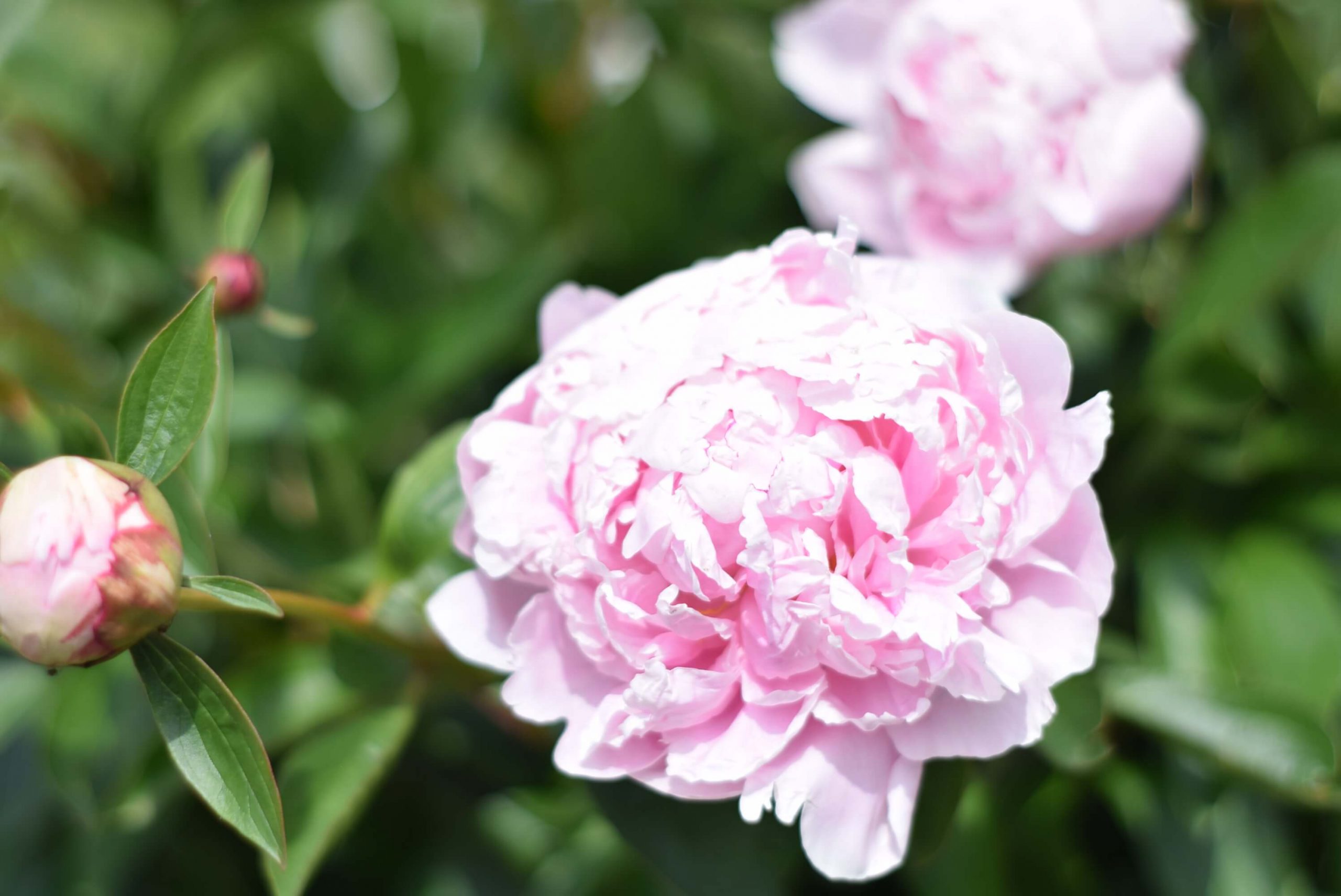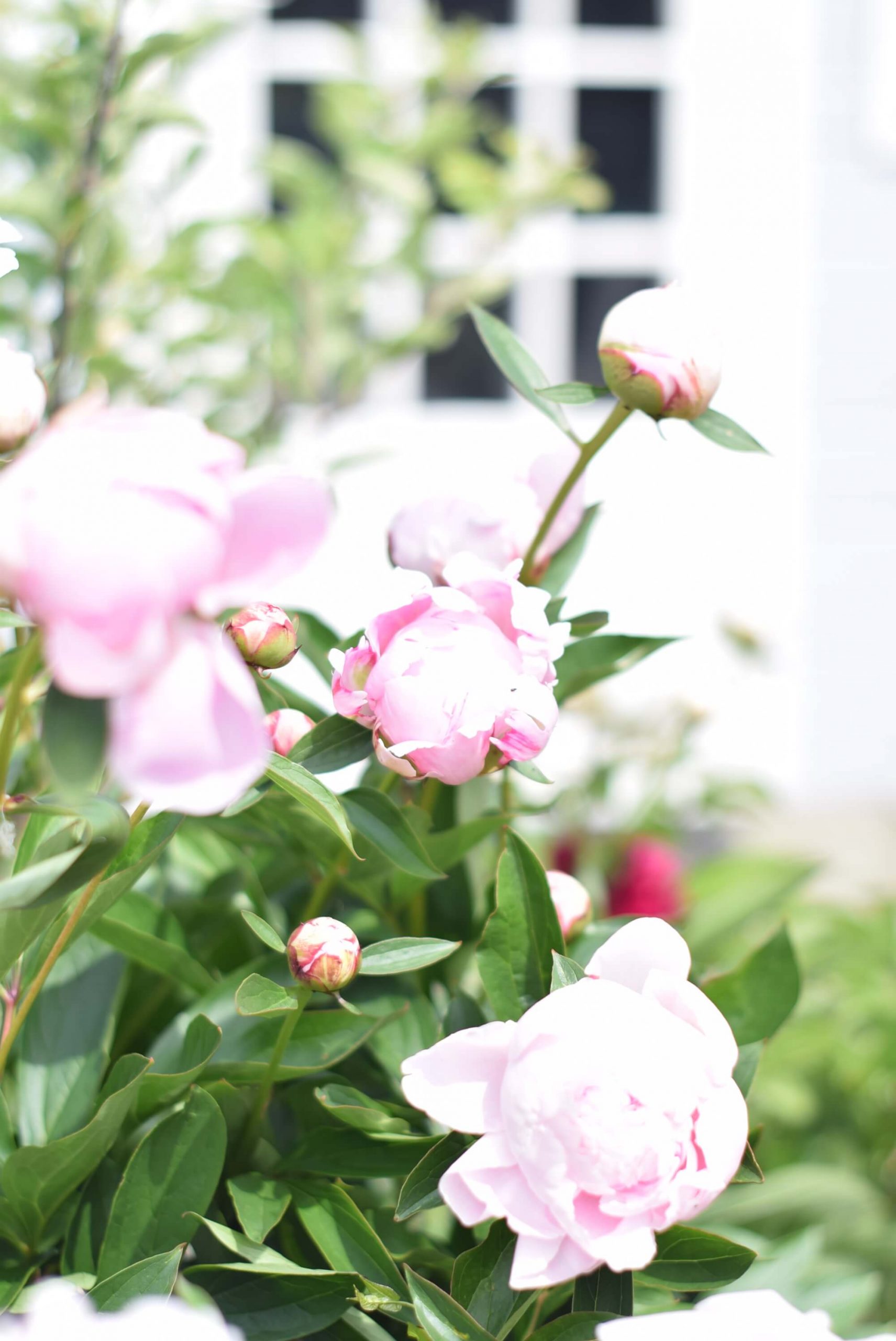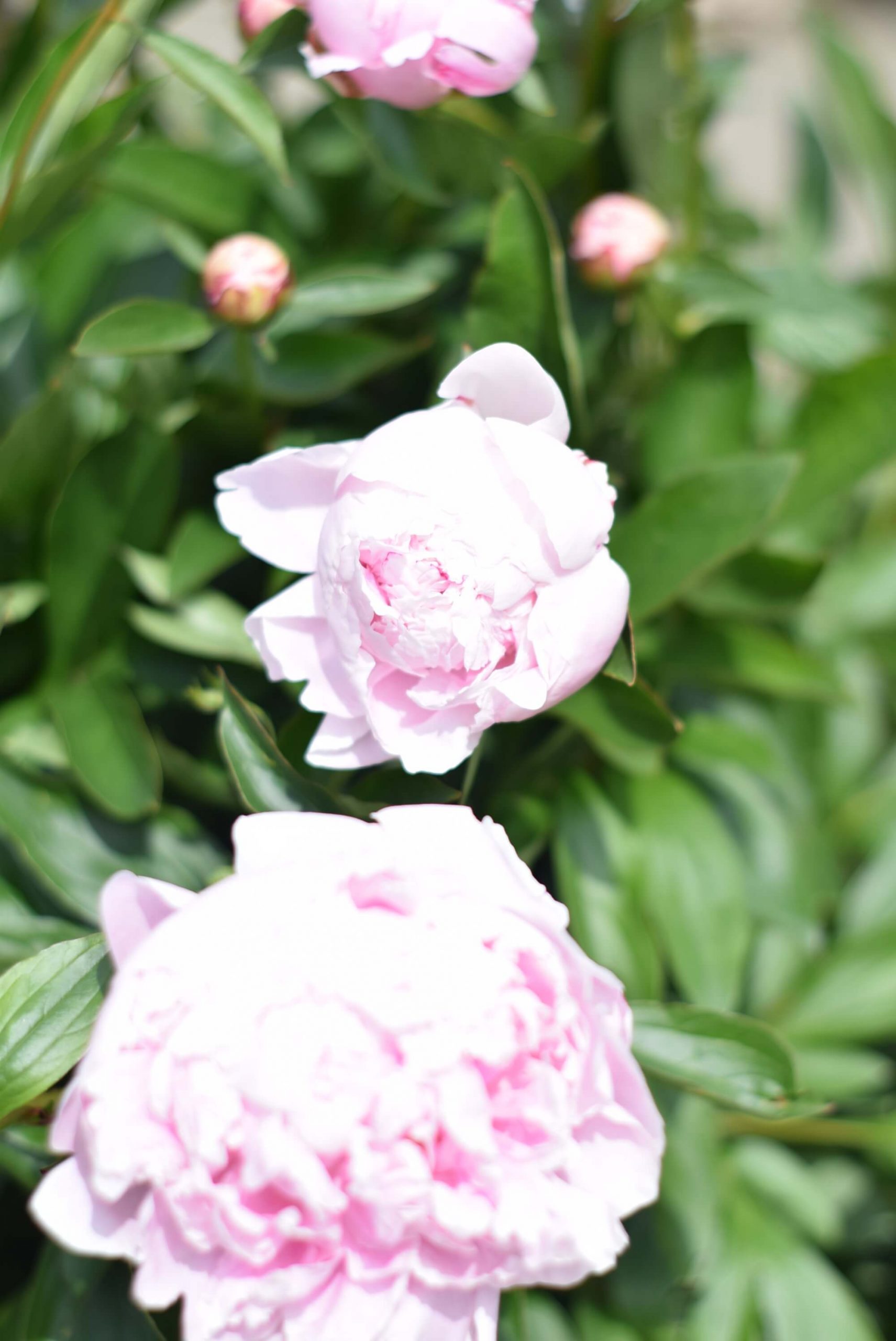A good peony fertilizer can make a big difference for your peony plants the following year. The kind of fertilizer you use strongly determines how healthy your peonies will be. An organic fertilizer will stimulate strong root development, which in turn makes healthy peonies that are can fight off fungal diseases. Also, a fertile soil increases the soil quality stimulating new growth which means more peony flowers to enjoy! Let’s see, how can you best care for your peonies? What is the best fertilizer for peonies?
This post may contain affiliate links, which means I make a small commission at no extra cost to you. See my full disclosure here. All opinions and experiences are my own.
Types of peonies
There are peonies in many colors and even fragrant peonies. But we can make a rough distinction between the tree peony and herbaceous peony.
Tree peonies have a woody stem and in principle do not need to be pruned. At the most, you can cut them somewhat to shape if the growth really gets too exuberant. Or, if there is dead wood on the plant, you can remove it in early spring. More detailed information about pruning peonies can be found in my post “How to care for peonies after bloom”.
In addition, there is the herbaceous peony. This type is also perennial and the stems and leaves of this type will dry and fall off in the fall. In the winter, it may seem there is little left of the peony plant. However, in early spring green shoots will appear again which form the stems and leaves. And finally, beautiful flowers that the peony is so loved for.

Soil quality
Probably the most important thing for a beautiful and fertile garden is the quality of the soil. The soil is the basis for good growth. To create a healthy soil, it is especially important that we give the soil time and not disturbe it too much. Constantly removing organic material may look neater, but ultimately this is not good for the quality of the soil.
Healthy soil has three properties. Namely, a good structure, soil life and sufficient available nutrients.
We can obtain a good structure by ensuring that the soil is sufficiently air permeable. A compact, clay soil where the roots of the peony can hardly get through can be improved by mixing in some sand. More sandy soil can be improved with clay minerals or matured compost. A good structure not only ensures that roots can form and spread well, but also that soil life can develop healthily
Continuing on this, the soil life ensures a good structure. It’s all connected! Small insects and worms make tunnels through the soil, which improves the structure of the soil. In addition, their droppings contribute to a nutrient-rich soil.
A nutrient-rich soil ensures that the plant gets all the nutrients it needs. If the same thing grows on one piece of land for a long time, the soil becomes exhausted. There are not enough nutrients lef in the soil to sustain healthy growth of the plants. If these are not supplemented by the application of organic fertilizer or organic matter, the plant will eventually weaken. This will make it more susceptible to certain diseases, weakening it and producing less beautiful flowers in the case of peony plants.
Fortunately, it can be solved with a little effort. Since you are reading this article, it shows that you are interested in the best fertilizer for peony plants. To better understand what happens if we don’t take good care of the peony and it becomes more susceptible to diseases. We’ll take a look at what diseases can do to the peony and then, what is the best fertilizer for peony plants.
Peony diseases
Although peonies are strong, perennial plants that can withstand some frost for example. Is it important to take care of them in such a way that they remain strong. A strong plant is much more resistant to diseases, grows better and thus produces more flowers.
A common peony disease is a fungal infection. Botrytis blight is one of these diseases. One of the characteristics by which you can recognize whether the plant is affected, is when a gray mold becomes visible. Eventually it affects the leaves and stems as well. They'll get brown spots which really makes them look not so pretty anymore. Also the flower buds and flowers can get affected. This happens when the sprouting stems rot when they are still small.
You can reduce the chance of your peony plants catching botrytis blight by ensuring that the soil in which the peony is planted is not too wet. So, make sure there's good drainage and air circulation. Also, by removing fallen leaves you ensure that a good air flow remains possible and the soil is not too moist.
Another common peony plant disease is called powdery mildew. This leaves a white/ grey powdery substance on the plant parts. It most likely won't damage the plant, but it takes from the beauty of the plant as it can cause deformed peony blooms and flowers as well. Additional information on peony plant diseases can be found on the Missouri Botanical Garden website.
You might like...
Garden planner
Be prepared and plan ahead for the coming gardening season.
Use code: PEONIES for 25% discount.
Click the image to go to garden planner
Organic fertilizer
A well-nourished peony plant is a healthy, thriving plant, so let's see how we can care for peonies and when to fertilize for best blooms. There are so many peony fertilizers to choose from, the choice can be overwhelming. Well, you can make the choice considerably easier by at least opting for organic fertilizers. When choosing a fertilizer always go for an organic fertilizer for your peony plants. That's simply the best type of fertilizer and here's why.
An organic fertilizer is a type of fertilizer made from organic material that finds its origin in nature. It can be made with the help of worms or other animals, from plants, or from naturally occurring materials such as lava meal. Since plants are "natural material" and thrive in good soil, which an organic fertilizer adds to, it's simply unnecessary to use synthetic fertilizer. It's better for the environment and it will work just as well, if not better.
When you choose an organic fertilizer you'll most likely come accros compost, bone meal, lava meal and cow manure. They are all good choices, but have different properties.


Compost
Compost is made from vegetable material such as the remains of vegetables and fruits. But yard waste can also be used to make good compost as well. It is a natural process in which the plant remains are slowly decomposed. This organic material still contains many valuable nutrients and are made readily available through the process of composting. Composting is really easy and if you have a garden it might as well be a good, new skill to learn. You can learn how to compost for your garden with Tessa from Sprig and Spoon. Or, use Deeanne's guide on Composting for beginners at Hummingbird Acres!
In the first year, when planting the new plants add some compost to the plant or mix some of the soil with compost in the planting hole. This will add essential nutrients to the soil while improving the soil quality. The compost will eventually be digested by the soil which leaves you with a healthy peony plant. You can't really go wrong with compost. It will be absorbed by the existing soil while nourishing the peony plants. You can't really overdo it because it's an organic fertilizer, but timing is important though.
Compost is also a good option when the peony plants are more mature. The compost can be added to the base of the peony plant in early spring when the shoots are about two inches tall. If you do this earlier, the peony is more likely to contract fungal diseases. The compost can then, in combination with wet and colder weather, cause the soil to remain too moist and inhibit sufficient air circulation. A little bit of compost between the young shoots and around the plant in early spring is enough.
Lava meal
You can also use lava meal to fertilize your peonies. Lava meal is a natural rock and therefore an organic fertilizer as well. Lava meal is full of minerals and trace elements. It contributes to a good soil structure and thereby ensures better drainage, especially in clay soil. With lava meal you can choose from powder or small rocks. When you choose powder, this is quickly and easily absorbed by the peony.
You can apply the lava meal around the peony plants in early spring. Sprinkle a little powder around the base of the peony plants and do this when the stems of the peony are already about 2 inches high. This will give you a strong peony and beautiful flowers in the spring. If you opt for lava meal in the form of small rocks, it is best to add it to the base of the plant after flowering in the fall or at the beginning of the winter. It can then be absorbed into the soil. It slowly releases its nutrients and the peony plants also benefit from it in the spring and flowering season.
You can also use the lava rocks as a kind of mulch. When the plant matures you can place the lava meal, in the form of small rocks, around the base of the peony. This ensures that the soil around the peony does not dry out so quickly in times of drought and acts as a slow release fertilizer. Due to the structure of the rocks you still ensure that there is good circulation of air.
Bone meal
Bone meal, as the name suggests, is made from ground animal bones. The bones contain many minerals and nutrients that are easily absorbed by the plant. This provides the peony with essential nutrients, which ensures a strong plant and good growth. Which ultimately makes for beautiful flowers. Bone meal is readily available and affordable. Just like lava flour, you can sprinkle it around the new peony shoots in early spring. The bone meal can be easily absorbed and this gives the peony plants extra nutrients for the new growing season.
When you regularly make bone broth you can make bone meal from the leftover bones by drying and grinding the bones after you no longer use them to make bone broth.
Cow manure
Probably one of the best known organic fertilizers is cow manure and this is also a good option for peonies. You just have to be a little more careful with the amount you use. In contrast to using lava flour or compost, with cow manure you can use too much . Cow manure is a good option because it contains many nutrients that strengthen the peonies and ensure good flowering in the spring. It's available in powdery form or small granules. You can choose whatever you prefer. Keep in mind that granules are easier to sprinkle. Especially on windy days, cow manure powder gets everywhere... Ahum, been there... A pro of cow manure in powder form is that it's absorbed a little faster than the granules that first have to break down.
You can also sprinkle cow manure around the plant in early spring. Do not do this on a very hot day, in full sun, but rather when it rains, so that the nutrients are absorbed better. Again, do not sprinkle the cow manure on the plant until the peony shoots are already a few inches high.
Never stop learning...

Subscribe to the newsletter and receive more inspiration on gardening + simple living.
You can unsubscribe any time
When to fertilize peonies?
So there is not one best fertilizer for peonies, you can choose from different fertilizers. You can choose from compost, lava meal, bone meal or cow manure. All three are good options, but with different properties. Take a good look at what your peonies need most. If you mainly want to improve the soil, compost is a good option, but if you want to add a lot of minerals and nutrients in a short time, then bone meal and lava meal are good options. Cow manure is a good option because it also provides a better soil, but at the same time adds the necessary nutrients to the soil.
As mentioned before, a good adult peony does not need a lot of nutrition in principle. Once every two or three years is really enough. This is partly due to the fact that the peonies store the nutrients from the stems and leaves in the roots to use again the following year. You can read more about this in my blog post on peonies.
In general, don't fertilize peonies until early spring when the peony shoots are several inches high. If you do this too early, the soil around the base of the peonies can stay too moist. That increases the risk of diseases. Early spring is the best time because then the peony can absorb the nutrients and use them for the coming growing season.
When you use lava flour in the form of small stones, you can do this at the end of the growing season when the leaves and stems of the peony have withered and the leaves fallen off. You can then place the small lava rocks around the base of the peony. They'll have all winter to be absorbed into the soil. The peony can then use the nutrients in early spring.
So, all in all, don't overdo it for your peonies. A mature peony plant doesn't really need much extra fertilizer. Improving soil quality and a sprinkle of organic fertilizer once in a while will do. That's about all the care you need to give your peonies.
Let's summarize...
Basically, peonies are strong plants, well-resistant to frost. A mature peony plant only needs to be fertilized every 2-3 years. Organic fertilizers are best for peony plants. Fertilize the peony plants in early spring when the peony plant's shoots are about 2 inches high. Fertilizing peonies with an organic fertilizer makes a strong plant, well-resistant to diseases and ensures pretty flowers the following year.
Helpful tools to care for your peonies:
- Organic compost (from your local gardening centre)
- Lava rocks for fertilizing and mulch
- Bone meal
- Cow manure (available from your local gardening centre)
- Plant cage to support the peonies
- Pruning shears for deadheading your peonies after blooming








